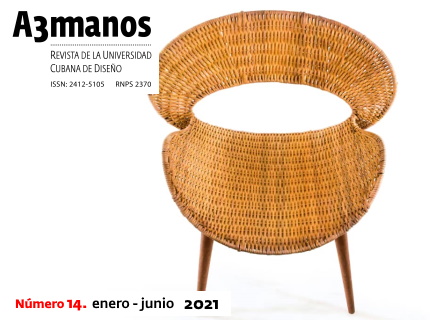Vol. 8 No. 14 (2021): No. 14 - january - june / 2021
The magazine: two great periods
Juan Emilio Martínez
In the history of the magazine, two great periods can be seen, the first one that goes from No. 1-2014 to 9-2018 and the second from No. 10-2019 onwards.
In this second moment, the publication is characterized by:
* A functional, clean and interactive interface.
* Five sections: Editorial, DISEÑOCONCIENCIA, ISDi Project, From the Academy and the Designer and his work.
* An average of 12 articles published in each issue.
* Strengthening the Editorial Committee and the Referees Committee with PhDs in design from other national and foreign institutions and universities.
* The requirements for their inclusion in databases of serial publications of impact I and II are satisfied.
* The magazine is being recognized by a greater number of teachers, researchers and designers as a space to publish and update themselves in the profession.
* A3manos becomes a construction publication continues to maintain the punctuality of its departure at the beginning of each semester.
These elements define, without a doubt, a maturing process of the magazine that drives forward, making it possible to:
* CITMA certification as a starting point and to be included in databases of serial publications of impact I or II.
* The presentation of the interface in several languages (English, Portuguese and Italian) although the official language for the publication of the articles is Spanish.
* Collaboration with other design and university scientific journals, including the option to exchange articles for publication.
* The recognition of the largest number of readers using the Design Registry ofthe National Design Office and social networks: Instagram, Pinterest, Fotki, Imgur, DeviantART, LinkedIn, Xing, among others.
The Editorial Committee of A3manos is confident of sustained growth with the support of all those who see it as a useful publication for the development of the profession and the training of designers.
Table of Contents
FORMA: Scientific production to support the teaching of Design
Eglis Cortina
Abstract
The work is the result of a documentary investigation of the International Congress of the Design ¨"FORMA¨", a meeting space between designers, businessmen, academics, publicists and students where they show their experiences, research and the prospective development of Design.
This exploration constitutes an exercise of informational competences to search and select information compiled in this great meeting, and thus favor the teaching of Design at the university.
The retrospective search from 2019 until its inception, allowed the characterization of these meetings, based on indicators such as: participating countries, foreign presentation, topics addressed, and invited personalities.The mode of transmission of these topics in teaching was confronted.
By way of conclusion, the academic acceptance of this Congress in International settings is evident. FORMA favors spaces for the dissemination of knowledge to strengthen the teaching- learning process of Design.
PEDRO MIRALLES and his CREATIVE PHILOSOPHY
Pilar Mellado
Abstract
Pedro Miralles Claver managed to demonstrate his eminent capacity for work, leaving a total of 42 projects as a legacy, many of them aimed at the ideation and development of complete furniture collections. From his creative beginnings, he knew how to give each one its own and unique meaning, prompting the establishment of a special bond between it and the user. Likewise, his professional career is characterized by the precision that he demanded in the details, both formally and constructively. Obtaining pieces of eminent aesthetic value, sober and elegant as a result. Characteristics that combined with each other define at the same time that they show the authentic transgressive character through which Miralles defined his particular creative philosophy.
The role of the international workshop in teaching design at ISDi
Raúl Bejerano
Mariela Cuevas
Abstract
The present article aims to expose the role of international workshops in teaching design at ISDi, as well as the main results obtained from carrying them out, and the impact they have had on stimulating the creative and investigative work of their participants.
The development of teaching activity requires a permanent commitment to training, research and professional updating. If the student is more focused to his own execution than to listen and consider the presentations of others, the idea of the collective construction of knowledge that also emerges from the experience provided by group work is lost, the application of the learned theory to objective reality, and the necessary link with the context in which it develops.
The “Workshops??? are intensive work study group, generally organized in blocks with time intervals for the attendees to rest. It is a term currently widely used in the business world to develop work in interdisciplinary groups, and as a teaching method it has reached a high number of followers because it encourages the exchange of experiences and encourages teamwork.
ISDi has proactively incorporated this method of direct contribution to teaching into its design careers, with an increasingly international character. This has allowed the attendees to participate actively, the increase of the collective creativity, a promotion of cultural exchange, the results before and after the workshop provides an important portion of cognitive novelty to students and teachers who share this experience.
The study methods used were observation and experimentation, and the interview and documentary analysis as associated techniques.























